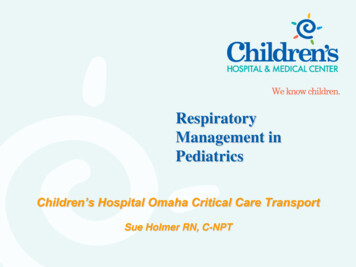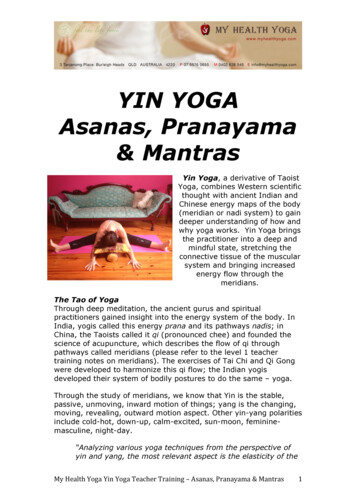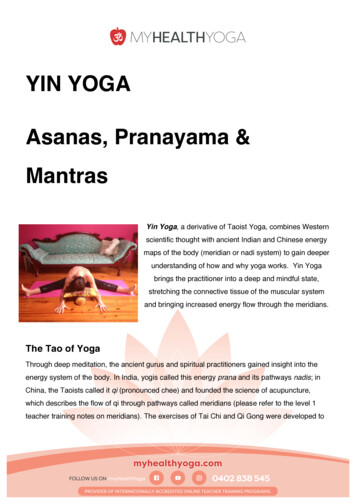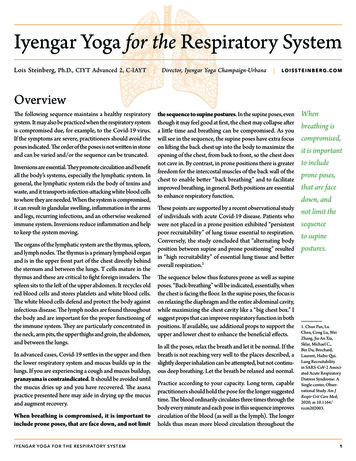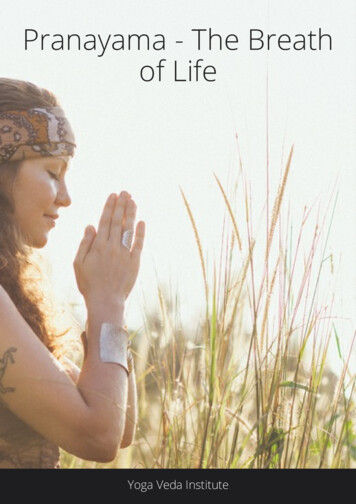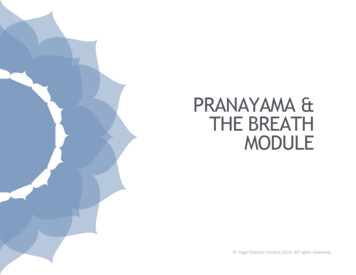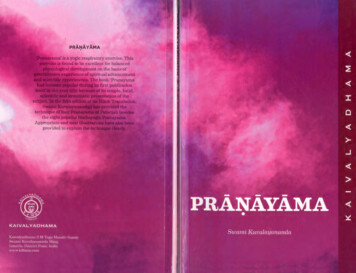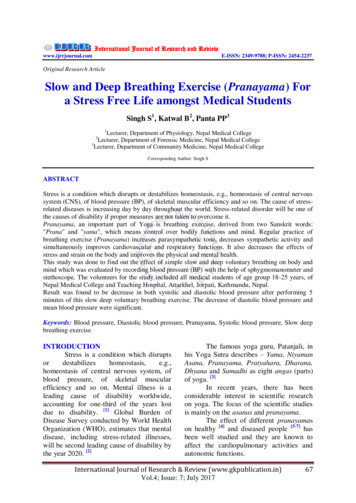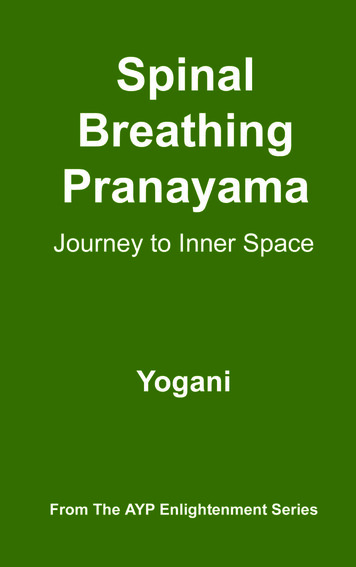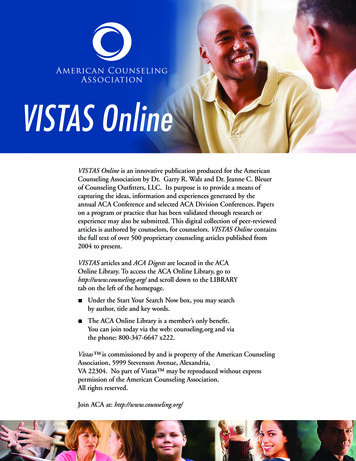
Transcription
17Overview ArticleAccess online at: www.ijsc.netInternational Journal of Science and ConsciousnessJune 2017, 3(2), 17- 23Facilitating Respiratory System Through PranayamaDr. Jitendra SharmaAssociate Professor, Mahatma Gandhi Chitrakoot Gramoday Vishvavidyalaya, M.P., India.AbstractAir is one of the minute form of cosmic energy, it is an energy, which is as essential as soul in thehuman body. One experiences this energy through breathing process, which is the most vitalprocess of the body. It influences the activities of each and every cell. The breath is intimatelylinked to all aspects of human experiences. This energy is regulated, maintained and can beenhanced through Pranayama. The process of controlling the Prana or vital life force is knownas Pranayama in Yoga science. Pranayama establishes regular breathing patterns, breaking thenegative cycle (Irregular breathing) and reversing the debilitations process. It does so by givingus control over the breath and re-establishing the natural, relaxed rhythms of the body and themind. Pranayama removes all the physical and mental Illness and makes life easy, simple andjoyful. We can see the descriptions of Pranayama in many different Ancient yogic scriptures.Pranayama not only maintains the physical energy level it also cures many diseases anddetoxifies the body indirectly. Maintenance of breathing keeps human respiratory systemshealthy forever and this one is the only purpose of Pranayama. In modern era many researcheshave been done on Pranayama and they have proved that deep and rhythmic breathing duringPranayama multiplies the efficiency of respiratory system.Keywords: Pranayama, Respiratory SystemArticle Received: 27-05-2017, Published: 03-06-2017Conflict of interest: None declared*Corresponding Author: Dr. Jitendra Sharma; Associate Professor, Mahatma Gandhi Chitrakoot GramodayVishvavidyalaya, M.P., India.International Journal of Science and Consciousness (IJSC): a Bio-Psycho-Spiritual approachPublished by the Research Foundation for Science & Consciousness, Uttarakhand, IndiaCopyright IJSC 2017 June 2017 Vol. 3 No. 2 Pages 17-23eISSN: 2455-2038An international, refereed, quarterly, open access, multidisciplinary, e-journal
18Facilitating Respiratory System Through PranayamaIntroduction:The Sanskrit word pranayama (alsoknown as pranayam) is translated as “the scienceof breath” in some circles, and in others it has abroader meaning, “expansion, manifestation ofenergy.” Pra (first unit) na (energy) is the vitaland primal energy of the universe. According tosome Indian writers, the universe comes fromakasha (ether, space) through the energy ofprana. Akasha is the infinite, raw material of theuniverse. Prana is the infinite, raw energy of theuniverse. One who has learned how to controlprana controls all the energies of the universe,thus controlling his or her body, emotions andmind.1Breath is an energizing force concerningthe matter in our bodies. Energy is referred to asprana in Sanskrit terms. Breath is our first andforemost energy, carrying over to all the otherbodies after reaching the physical body. Even thephysical body comes after energy, not before. Wetalk about mental energy, emotional energy,physical energy, spiritual energy all of these aretypes of prana.Four aspects of pranayama:In the pranayama practices there are fourimportant aspects of breathing which areutilised. These are:1. Pooraka or inhalation2. Rechaka or exhalation3. Antarkunbhaka or internal breath retention4. Bahir kumbhaka or external breath retention.The different practices of pranayamainvolve various techniques which utilise thesefour aspects of breathing. There is another modeof pranayama which is called kevalakumbhaka orspontaneous breath retention. This is anadvanced stage of pranayama which occursduring high states of meditation.2 During thisstate, the lungs stop their activity and therespiration ceases. At this time, the veil whichprevents one from seeing the subtle aspect ofexistence is lifted and a higher vision of reality isattained.The most important part of pranayama isactually kumbhaka or breath retention. However,in order to perform kumbhakasuccessfully, theremust be a gradual development of control overthe function of respiration. Therefore, in thepranayama practices more emphasis is given toinhalation and exhalation at the beginning, inorder to strengthen the lungs and balance thenervous and pranic systems in preparation forthe practice of kumbhaka. These practicesinfluence the flow of prana in the nadis,purifying, regulating and activating them,thereby inducing physical and mental stability.(For more information on nadis see the chapterPsychic Physiology of Yoga.)The Pranic bodyAccording to yogic physiology, the humanframework is comprised of five bodies orsheaths, which account for the different aspectsor dimensions of human existence.3 These fivesheaths are known as:1. Annamaya kosha, the food or material body2. Manomaya kosha, the mental body3. Pranamaya kosha, the bioplasmic or vitalenergy body4. Vijnanamaya kosha, the psychic or highermental body5. Anandamaya kosha, the transcendental or blissbody.Although these five sheaths functiontogether to form an integral whole, the practicesof pranayama work mainly with pranamayaCopyright IJSC 2017 June 2017 Vol. 3 No. 2 Pages 17-23eISSN: 2455-2038An international, refereed, quarterly, open access, multidisciplinary, e-journal
kosha. The pranamaya kosha is made up of fivemajor pranas which are collectively known asthe pancha, or five, pranas: prana, apana,samana, udana and vyana.Even though prana is a term loosely usedto cover all energies, ancient manuals of yogaspeak of ten pranas, five major and five minorones. The five major pranas are udana, prana,samana, apana, and vyana.Udana rules the upper part of the bodyfrom the larynx up, and governs use of specialsenses beyond the five senses.Prana rules between the larynx and theheart, governing speech, breath and therespiratory system.Samana rules between the heart and thenavel, governing all metabolic activity in the actof digestion.Apana rules below the navel and governsthe kidneys, colon, rectum bladder and genitals.Vyana permeates the entire body andgoverns relaxation and contraction of allmuscles, voluntary or involuntary. It alsogoverns the joints and their movements. Bycontrolling the prana (breath) one can accessand influence all the other pranas, whichexplains the universal usage of this word forrepresenting all the pranas.4Breath and Health:The breath is the most vital process ofthe body. It influences the activities of each andevery cell and, most importantly, is intimatelylinked with the performance of the brain. Humanbeings breathe about 15 times per minute and21,600 times per day. Respiration fuels theburning of oxygen and glucose, producing energyto power every muscular contraction, glandularsecretion and mental process.6 The breath isintimately linked to all aspects of humanexperience. Most people breathe incorrectly,using only a small part of their lung capacity. Thebreathing is then generally shallow, deprivingthe body of oxygen and prana essential to itsgood health. The first five practices given in thissection are preparatory techniques whichintroduce correct breathing habits. In addition,they help focus the awareness on the breathingprocess, which is otherwise normally ignored.Practitioners develop sensitivity to therespiratory process and retrain the muscles ofthe pulmonary cavity, enhancing their vitalcapacity and preparing them for pranayama.Rhythmic, deep and slow respirationstimulates and is stimulated by calm, contentstates of mind. Irregular breathing disrupts therhythms of the brain and leads to physical,emotional and mental blocks. These, in turn, leadto inner conflict, imbalanced personality,disordered lifestyle and disease. king this negative cycle and reversing theprocess. It does so by taking control of the breathand re-establishing the natural, relaxed rhythmsof the body and mind.[5,6,7,8,]Although breathing is mainly anunconscious process, conscious control of it maybe taken at any time. Consequently, it forms abridge between the conscious and unconsciousareas of the mind. Through the practice ofPranayama, the energy trapped in neurotic,unconscious mental patterns may be released foruse in more creative and joyful activity.Performing hus being established in asana andhaving control (of the body), taking a balanceddiet; Pranayamas should be practiced accordingto the instructions of the guru.Hatha Yoga Pradipika (2:1)According to our ancient scripture one whowants to practice the Pranayama should practiceunder the great guidance or under supervision ofCopyright IJSC 2017 June 2017 Vol. 3 No. 2 Pages 17-23eISSN: 2455-2038An international, refereed, quarterly, open access, multidisciplinary, e-journal
guru. The Pranayama can make an adverse effecttowards practioner if he does the Pranayamawrongly. So, practioner needs to follow theguidelines mentioned in the scripture.Most people breathe incorrectly, usingonly a small part of their lung capacity. Thebreathing is then generally shallow, deprivingthe body of oxygen and prana essential to itsgood health. The first five practices given in thissection are preparatory techniques whichintroduce correct breathing habits. In addition,they help focus the awareness on the breathingprocess, which is otherwise normally ignored.Practitioners develop sensitivity to therespiratory process and retrain the muscles ofthe pulmonary cavity, enhancing their vitalcapacity and preparing them for pranayama.pranayamas may be performed before sleep. Tryto practise regularly at the same time and placeeach day. Regularity in practice increasesstrength and willpower as well as acclimatisingthe body and mind to the increased pranic force.Do not be in a hurry; slow, steady progress isessential.Guidelines for the Pranayama:In the traditional texts, there areinnumerable rules and regulations pertaining topranayama. The main points are to exercisemoderation, balance and common sense withregard to inner and outer thinking and living.However, for those who seriously wish to take upthe advanced practices of pranayama, theguidance of a guru or experienced teacher isessential.Breathing: Always breathe through the nose andnot the mouth unless specifically instructedotherwise. The nose should be cleaned regularlyby jalaneti prior to the practice session. Be awareof the nostrils throughout the techniques. Whileinhaling, the nostrils should dilate or expandoutwards and while exhaling, they should relaxback to their normal position.Sitting position: A. comfortable, sustainablemeditation posture is necessary to enableefficient breathing and body steadiness duringthe practice. Siddha/siddha yoni asana is one ofthe best postures for pranayama. The bodyshould be as relaxed as possible throughout thepractice with the spine, neck and head erect. Siton a folded blanket or cloth of natural fibre toensure the maximum conduction of energyduring the practice.Time of practice: The best time to practisepranayama is during the early morning when thebody is fresh and the mind has very fewimpressions. If this is not possible, another goodtime is just after sunset. TranquillisingPlace of practice: Practise in a quiet, clean andpleasant room which is well ventilated but notdraughty. Generally, avoid practising in directsunlight, as the body will become over-heated,except at dawn when the soft rays of the earlymorning sun are beneficial. Practising in adraught or wind, in air-conditioning or under afan may upset the body temperature and causechills.Sequence: Pranayama should be performedafter asanas and before meditation practice.After practising pranayamaone may lie down inshavasana for a few minutes.Clothes: Loose, comfortable clothing made ofnatural fibres should be worn during thepractice. The body may be covered with a sheetor blanket when it is cold or to keep insectsaway.Bathing: Take a bath or shower beforecommencing the practice, or at least wash theCopyright IJSC 2017 June 2017 Vol. 3 No. 2 Pages 17-23eISSN: 2455-2038An international, refereed, quarterly, open access, multidisciplinary, e-journal
hands, face and feet. Do not take a bath for atleast half an hour after the practice to allow thebody temperature to normalise.Empty stomach: Wait at least three to fourhours after meals before starting pranayama.Food in the stomach places pressure on thediaphragm and lungs, making full, deeprespiration difficult.Side effects: When practising for the first time,various symptoms may manifest in normallyhealthy people. These are caused by the processof purification and the expulsion of toxins.Sensations of itching, tingling, heat or cold andfeelings of lightness or heaviness may occur.Such experiences are generally temporary but ifthey persist during the practice, check with ayoga teacher.Digestion: When commencing pranayamapractice, constipation and a reduction in thequantity of urine may be experienced. In the caseof dry motion, stop taking salt and spices, anddrink plenty of water. In the case of loose motion,stop the practices for a few days and go on a dietof rice and curd or yoghurt.Contra-indications: Pranayama should not bepractised during illness, although simpletechniques such as breath awareness andabdominal breathing in shavasana may beperformed. Always consult a yoga therapist orteacher before using any pranayama fortherapeutic purposes.Diet: A balanced diet of protein, carbohydrates,fats, vitamins and minerals is suitable for mostpranayama practices. A combination of grains,pulses, fresh fruit and vegetables, with a littlemilk product if necessary, is recommended. Themore advanced stages of pranayama require achange in diet and a guru should be consulted forguidance on this.No smoking: It is not advisable for pranayamapractitioners to smoke tobacco or cannabis.Avoid strain: With all pranayama practices it isimportant to remember that the instruction notto strain, not to try toincrease your capacity toofast, applies just as it does to asana practice. Ifone is advised to practise a pranayamatechniquefor a specific length of time, beforemoving on to a more advanced practice or ratio,it is wise to follow that instruction. Furthermore,breath retention should only be practised for aslong as is comfortable. The lungs are verydelicate organs and any misuse can easily causethem injury. Not only the physical body but alsothe mental and emotional aspects of thepersonality need time to adjust. Never strain inany way.Mechanism of Pranayama:The air is drawn into the lungs by theaction of the diaphragm. When it expands, thesize of the chest and lungs is increased and theoutside air rushes into the vacuum thus created.The chest and lungs contract, when diaphragmrelaxes and the air is expelled from the lungs. Itis through vocal cords that are located in thelarynx that sound is produced. Larynx is thesounding box. When the vocal cords are affectedby too much straining, as in singing andcontinuous lecturing, the voice becomes hoarse.In females these cords are shorter. Hence theyhave a sweet melodious voice. The number ofrespiration per minute is 16. In pneumonia it isincreased to 60, 70, 80 per minute. In Asthma,the bronchial tubes become spasmodic. Theycontract. Hence there is difficulty in breathing.Pranayama removes the spasm or constriction ofthese tubes. A small membranous flat cap coversthe upper surface of larynx. It is called Epiglottis.Copyright IJSC 2017 June 2017 Vol. 3 No. 2 Pages 17-23eISSN: 2455-2038An international, refereed, quarterly, open access, multidisciplinary, e-journal
It prevents the food particles or water fromentering into the respiratory passage. It acts thepart of a safety valve.When a small particle of food tries toenter the respiratory passage, cough comes inand the particle is thrown out. Lungs purify theblood. The blood starts in its arterial journey,bright-red and rich-laden with life-givingqualities and properties. It returns by the venousroute, poor, blue-laden with the waste matter ofthe system.9 Arteries are tubes or vessels thatcarry pure oxygenated blood from the hearttowards the different parts of the body. Veins arevessels or tubes that carry back impure bloodfrom the different parts of the body. The rightside of the heart contains impure venous blood.From the right side of the heart the impure bloodgoes to the lungs, for purification. It isdistributed among the millions of tiny air-cells ofthe lungs. A breath of air is inhaled and theoxygen of the air comes in contact with theimpure blood through the thin walls of the hairlike blood-vessels of the lungs called pulmonarycapillaries. The walls of the capillaries are verythin. They are like muslin cloth or sieve. Bloodoozes out or exudes readily. Oxygen penetratesthrough the walls of these thin capillaries. Whenthe oxygen comes in contact with the tissues aform of combustion takes place.The blood takes up oxygen and releasescarbonic acid gas generated from the wasteproducts and poisonous matter, which has beengathered up by the blood from all parts of thesystem. The purified blood is carried by the fourpulmonary veins to the left auricle and thence tothe left ventricle. From the ventricle it is pumpedinto the biggest artery, aorta. From aorta, itpasses into the different arteries of the body.10 Itis estimated that in a day 35,000 pints of bloodtraverses the capillaries of the lungs forpurification. From the arteries the pure bloodgoes into the thin capillaries. From the capillariesthe lymph of the blood exudes, bathes andnourishes the tissues of the body. Tissuerespiration takes place in the tissues. Tissuestake up the oxygen and leave the carbon dioxide.The impurities are taken by the veins to the rightside of the heart. Who is the creator of thisdelicate structure? Are you feeling the invisiblehand of God behind these organs? The structureof this body bespeaks undoubtedly of theomniscience of the Lord. The Antaryamin or theIndweller of our hearts supervises the workingof the inner factory asrashtha. Without Hispresence, heart cannot pump blood into thearteries. Lungs cannot carry out the process ofpurifying the blood. Pray. Pay your silent homageto Him. Remember Him at all times. Feel Hispresence in all the cells of the body.Conclusion:It can be concluded as the Pranayamacan make a significant difference in the term ofphysical, mental, social and spiritual Health ofmankind if it is practiced as mentioned inspiritual scriptures.References:1. http://www.dlshq.org/download/pranayama2. /light on pranayama b k s iyengar3. Verma, S., Kashyap, G. K., Kumar, K. (2016).Can Pranakarshan Pranayam helps to copeup the stress? International Journal of Scienceand Consciousness; 2(2): 38- 45.4. https://umsonline.org/PrinterFriendly/Pranayama5. http://yoga10.org/Documents/pranayamamail6. Verma S. et.al. (march 2016), A Study on theEffect of Collective Yogic Practices on SocialAdjustment of Collage Students in UrbanArea, International Journal of Science andConsciousness (IJSC), Vol. 2, No. 1, Pages 3640.Copyright IJSC 2017 June 2017 Vol. 3 No. 2 Pages 17-23eISSN: 2455-2038An international, refereed, quarterly, open access, multidisciplinary, e-journal
7. Verma, S. and Gurvendra, A. (2016). A Studyon the Effect of Collective Yogic Practices onSocial Adjustment of Collage Students inUrban Area. International Journal of Scienceand Consciousness; 2(1): 36-40.8. r Pranayama9. araswati---Asana-Pranayama-MudraBandha10. http://www.aypsite.org/books-sbp-sampleCite this paper as: Sharma, J. (2017). Facilitating Respiratory System ThroughPranayama. International Journal of Science and Consciousness; 3(2): 17-23.Copyright IJSC 2017 June 2017 Vol. 3 No. 2 Pages 17-23eISSN: 2455-2038An international, refereed, quarterly, open access, multidisciplinary, e-journal
The different practices of pranayama involve various techniques which utilise these four aspects of breathing. Th ere is another mode of pranayama which is called kevalakumbhaka or spontaneous breath retention. This is an advanced stage of pranayama whi
